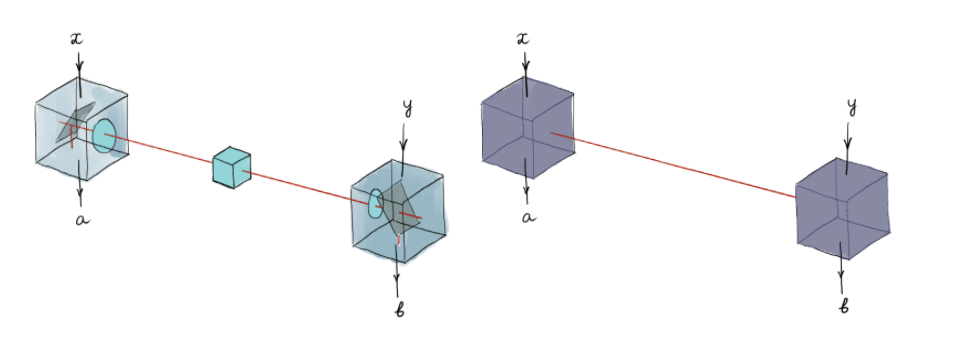Quantum Cryptography
We develop new mathematical techniques that can be used in security proofs for quantum cryptography, making it easier to develop and certify novel protocols.
Quantum cryptography relies on inherently quantum mechanical behaviour to perform tasks such as secure communication and generating private randomness. It is a fairly mature quantum technology, and a number of commercial devices are available today.
However, proving the security of quantum protocols is often a challenging task, especially when issues of finite key length and non-i.i.d. behaviour — that is, when the devices are not independent and identically distributed — have to be taken into account.
Device-independent cryptography

Currently, one of our research focuses is the development of proof techniques applicable to device-independent protocols [1,2]. This field sits at the intersection of quantum foundations and cryptography, exploiting 'nonlocal' quantum behaviour to certify protocol security while only requiring minimal assumptions about the devices. This very strong form of security comes with the drawback that only a few proof techniques are known for these scenarios, making it difficult to develop protocols that can be both proven secure and implemented in the lab. We aim to find various methods [3,4] to help close this gap and explore possibilities for other device-independent protocols.
References
- Rotem Arnon-Friedman, Renato Renner and Thomas Vidick. Simple and tight device-independent security proofs. SIAM J. Comput. 48.1, 181-225 (2019). external page doi: 10.1137/18M1174726 external page arXiv:1607.01797
- Rotem Arnon-Friedman, Frédéric Dupuis, Omar Fawzi, Renato Renner and Thomas Vidick. Practical device-independent quantum cryptography via entropy accumulation. Nat. Commun. 9, 459 (2018). external page doi: 10.1038/s41467-017-02307-4
- Ernest Y.-Z. Tan, Charles C.-W. Lim and Renato Renner. Advantage distillation for device-independent quantum key distribution. Phys. Rev. Lett. 124, 020502 (2020). external page doi: 10.1103/PhysRevLett.124.020502 external page arXiv:1903.10535
- Ernest Y.-Z. Tan, René Schwonnek, Koon Tong Goh, Ignatius William Primaatmaja and Charles C.-W. Lim. Computing secure key rates for quantum key distribution with untrusted devices. external page arXiv:1908.11372